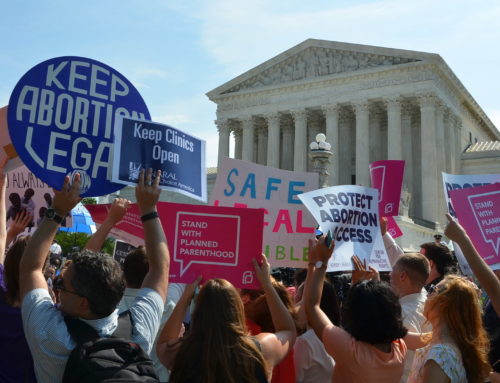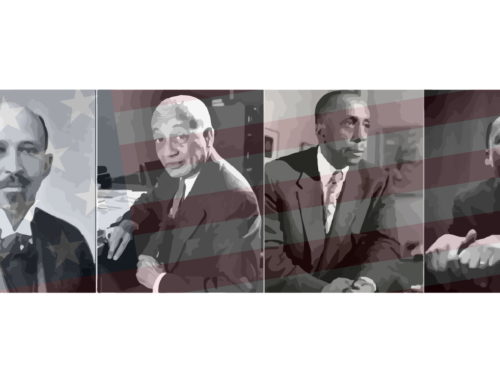By: Hendrik van der Breggen
This article is part of a debate on abortion. For an introduction see: Arguing Dialectically about Abortion. For an opposing view see: Philosophical Arguments for Abortion.
I favor the pro-life position on the abortion issue, all the while realizing that many good and decent people disagree with me. Why do they disagree? It seems they are influenced by popular claims and arguments favoring the pro-choice view.
I intend no disrespect to anyone in saying this, but I think that many popular claims and arguments favoring the choice for abortion consist of knots of illogic that should be untangled.
Consider the following sixteen knots.
1. Pro-lifers/anti-abortionists are anti-choice.
Reply: In one sense, yes. That is, on the pro-life/anti-abortion view, choice for abortion gets limited (though pro-lifers might disagree to what extent this should be: no abortions allowed at all, or no late-term abortions only, or abortions allowed only for special cases such as rape, incest, threat to life of the mother).
But in another very important sense, no, pro-lifers/anti-abortionists are not anti-choice. They favor women having the usual choices everyone else has (e.g., career, education, marriage, voting, etc.) but they also realize that each abortion wipes out a whole life-time of choices—so anti-abortionists increase the total of choices.
2. The human fetus is merely a potential human being.
Reply: No, the fetus is a human being with potential, not a potential human being.
Contemporary science—embryology, fetology, and biology—tells us that the human fetus is in fact a human being. It’s a genetically distinct, self-governing dynamic organism/ entity that belongs to the human species. It’s not feline or canine; it’s human. It’s not a cat or a dog; it’s a human being. It’s not a kitten or a puppy; it’s a child, albeit an unborn child. (The word “fetus” is Latin for unborn offspring or little one.)
Significantly, 95% of academic biologists in a recent global survey hold that individual human life begins at fertilization. For additional scientific evidence, see “The origin of human life at fertilization: Quotes from medical textbooks and peer-reviewed scientific literature.”
The fetus, then, is a developmental stage of human being, i.e., it’s a human being that becomes the subsequent stages (if no interference or malfunction occurs). Again, the fetus is not a potential human being, rather it’s a human being with potential. A potential human being is the sperm and egg before union.
3. Abortion is just another means of contraception.
Reply: No. A contraceptive prevents the union of sperm and egg. Abortion destroys the human being created by the union of sperm with egg.
4. Abortion is simply the termination of pregnancy.
Reply: The words “termination of pregnancy” are a euphemism (nice words to cover up something not nice). Birth is also the termination of pregnancy. Abortion, however, destroys the pre-natal human being, often by ripping off limbs and crushing skulls.
5. A brick is not a house, so getting rid of a brick or even a few bricks is no big deal, so abortion is no big deal. (This pro-choice argument is from Canada’s famous abortionist Dr. Henry Morgentaler.)
Reply: Yes, but if you had a brick that grows into a house complete with furnace, air conditioning, blue curtains, a super-computer, plus plumbing (plumbing that, unfortunately, leaks for the first couple years), you probably wouldn’t destroy that brick. (For further argument, see here.)
6. An acorn isn’t an oak tree, so the fetus isn’t a human being, so abortion is no big deal.
Reply: To compare an acorn to a fetus and an oak tree to a human being and then conclude that a fetus is not a human being is to draw a false conclusion from a faulty analogy.
The unstated premise consists of the following comparison: acorns are to oak trees as fetuses are to human beings. But this is problematic.
To call an acorn an oak tree is, on a more accurately construed analogy, like calling a fetus an adult. Consequently, to say that a fetus is not a human being on the basis of an acorn not being an oak tree is to say a fetus is not a human being on the basis of a fetus not being an adult. This is mistaken.
In other words, the acorn-oak tree analogy confuses the concepts of kind and developmental stage. Yes, an acorn isn’t an oak tree, that is, a seed isn’t a grown tree. But we need to ask: What kind of seed is the acorn? Answer: Oak.
The acorn is the first developmental stage of the oak. Subsequent developmental stages include sprout, sapling, and tree. Significantly, all the stages are oaks—i.e., oak entities, oak beings.
Now consider the fetus. What kind of fetus are we talking about? Answer: Human.
The fetus is an early developmental stage of the human. The first stage is the zygote (fertilized egg) and subsequent stages include the embryo, fetus, infant, toddler, teen, and adult. Significantly, all the stages are human—i.e., human entities, human beings.
An acorn isn’t an oak tree, so the fetus isn’t a human being, so abortion is no big deal? The logic of this argument is just plain nutty. (Sorry, I couldn’t resist the attempt at humor.)
Is it a mistake to call a fetus a human being? No. What is a mistake is to think that only adults are human beings, which is what the faulty acorn-oak-tree analogy would lead us to believe.
7. The unborn human being/fetus isn’t a “person,” so abortion is morally permissible.
Reply: Here we need to think carefully about personhood. The idea behind this pro-choice argument is that the unborn human being lacks some specific feature which makes it a person and thereby confers the right to life to it. But this approach to personhood is problematic for several reasons.
First, the so-called decisive features that are allegedly required for personhood weaken the personhood of many human beings who in fact have the right to life.
For example, if consciousness or having desires or feelings or exercising some degree of rationality is a crucial criterion of personhood, then the right to life of sleeping, stunned, or mentally disabled persons or even infants is jeopardized. The equality in equal rights gets ungrounded.
Second, pointing to a feature such as consciousness or having desires or feelings or rationality as the basis of the right to life confuses a sufficient condition for a necessary condition. Yes, if one has such a feature, then that’s enough to confer the right to life. It’s a sufficient condition or indicator of the right to life. But a question remains: What is it that is needed or necessary for such a feature to hold in the first place to ground the right to life in the cases of sleeping, stunned, or mentally disabled persons or even infants? It very much seems that the human being’s capacity for such features is necessary to make sense of conferring onto them the right to life. But this capacity is what the fetus has.
At this juncture, one might object that the mental state of the fetus is more like a permanently comatose condition or permanently vegetative state than someone who is sleeping, stunned, or mentally disabled, so just as the natural ending of one’s consciousness marks the absence of the right to life (as in the case, arguably, of the permanently comatose or permanently vegetative individual), so the fetus who isn’t conscious doesn’t yet exist as a person, so no harm is done to any person by killing a fetus via abortion.
In reply, the analogy is faulty. The state of being of the fetus is more like a non-permanent coma or non-permanent vegetative state: the fetus will awaken—if we don’t kill him/her. This is as morally significant in the case of the fetus as it is of the individual in a non-permanent coma or non-permanent vegetative state (even if that person were previously always in such a state).
Also, to push the point further (by looking at its possible negative consequences), if non-consciousness or not having desires or feelings were sufficient to justify killing a fetus, then it would be morally permissible (if medically possible) to alter a fetus’s nervous system so consciousness would never arise. This would then allow us to let the fetus grow into its later stages and be a source of body parts for the rest of us. (Think of the 2005 movie The Island, starring Scarlett Johansson and Ewan McGregor, but instead of docile intelligent clones they would be more like zombies.) But this isn’t morally permissible, surely. And this moral impermissibility counts against the view that the fetus’s non-consciousness disqualifies it for the right to life.
Third, because of reasons such as those above (and others), it’s clear that we can cast some serious doubt onto the view that a preborn human child/fetus is not a person—but if so, then we should err on the side of caution by not killing the fetus. Just as when I’m not sure whether there’s a deer or a fellow hunter behind the trees, I should err on not shooting.
8. Every child should be a wanted child. (This is from Canada’s famous abortionist Dr. Henry Morgentaler, again.)
Reply: Yes, but these words neglect the truth that instead of enhancing the wantedness of unwanted pre-natal children, abortion kills them. Everyone should have a home and be loved, but this doesn’t mean we should kill the homeless and unloved—nor those who might become homeless and unloved.
9. Pro-lifers aren’t helping people after they’re born.
Reply: Maybe some aren’t. But many are. Witness the proliferation of crisis pregnancy centers. Also, witness the fantastic response gotten from a newspaper editor who asked (disparagingly, expecting no good answers) what pro-life people have done personally to help lower-income single moms. It turns out that pro-life people do a lot! See here.
Permit me to speak from personal experience. My wife Carla is deeply pro-life. But she is also humble and doesn’t talk much about the good things she does. She sees such talk as morally inappropriate—as bragging. So I will brag on her behalf!
When Carla and I were dating and during our first years of marriage, Carla worked in a group home caring for—helping—children who were severely handicapped physically and mentally.
Later (while I was completing my PhD and beginning to teach philosophy courses) we lived in a low-income, high crime neighborhood for eleven years. During this time Carla began (along with a couple of friends) a community center to help our needy neighbors. Carla also tutored some of our neighbors’ kids. She also taught single parents how to make inexpensive but nutritious meals (she even took the time to become certified by our local health department to do this). She also helped organize a weekly food distribution. She also helped a neighbor (a single mom with five kids) learn to drive, obtain a driver’s license, and find some part-time employment (subsequently Carla often loaned our car to this mom for grocery shopping). Carla also helped a young woman deal with her abusive husband. Carla also used her nurse training to help injured neighbors as well as neighbors with young children, including a home birth. And there’s much more, but space doesn’t permit. (She also homeschooled our two sons during this time!)
You get the picture: pro-life people (like my wife) are against abortion and they often do lots of good stuff—which we tend not to hear about.
Also, a logical point should be made: Even if pro-lifers weren’t (contrary to fact) helping people after they’re born, this would not make killing of unborn children morally correct. Pro-lifers argue that killing unborn children is wrong, period, so the critics’ objection is beside the point. The objection is irrelevant, in other words. It would only make pro-lifers hypocrites.
(Note: Hopefully, pro-choicers are helping people after they’re born, too, to provide a real choice, and thus not merely advocating for the right to kill unborn children.)
10. Not allowing abortion is to impose your morality onto others.
Reply: But killing another human being is the ultimate imposition of morality onto that other human being. Not allowing abortion is a less severe imposition of morality.
11. Rape, incest, and protection of life or health of mother justify the general abortion practice.
Reply: No. Arguments that abortions are necessary for these special situations are legitimate (if at all) only for those situations. In North America these special situations account for less than 5% of the total. To justify the total practice on the basis of 5% is a hasty generalization (i.e., a mistake in reasoning).
12. Rape justifies abortion.
Reply: Rape is wrong, definitely. But perspective is needed.
Of the total abortion practice, abortions for rape account for a small percentage only (less than 5%).
Also, the mother has been victimized—she needs care. Abortion does not undo the trauma of rape. Moreover, abortion can be traumatic, too. And abortion may be related to subsequent health problems (see the film Hush).
Furthermore, to kill by abortion the human being conceived by the crime of rape is like killing an innocent bystander at the scene of a crime, a crime perpetrated by the bystander’s father. The father deserves (severe) punishment, not the child.
Rape justifies abortion? Perhaps. Perhaps not. What is certain is that we shouldn’t victimize a woman twice. Also, we should speak for those who can’t. And we should listen to those persons who were conceived in rape (see video Conceived in rape by Rebecca Kiessling et al.).
13. The life-of-mother-versus-life-of-child situation justifies abortion.
Reply: Yes, possibly, as self-defense. But this situation is rare in North America. It’s very rare, if not non-existent.
Dr. Kendra Kolb, a neonatalogist, recently stated this: “there is no medical reason why the life of the child must be directly and intentionally ended with an abortion procedure.”
Also, Dr. C. Everett Koop in 1980 (when he was Surgeon General of the United States) stated the following: “In my thirty-six years in pediatric surgery I have never known of one instance where the child had to be aborted to save the mother’s life” (source: C. Everett Koop, “Deception-on-demand,” Moody Monthly, May 1980, p. 27).
Again, justifying the general situation on basis of small percentage is a hasty generalization.
14. Every woman has the right to control her body, so every woman has the right to abortion.
Reply: But abortion involves two bodies. The right to control one’s own body is one thing; the right to kill another’s body is quite another. I have the right to swing my fist, but that right ends at the tip of another’s nose.
(Those who insist that the fetus is part of the woman’s body make a conceptual mistake, as I argue here.)
15. Difficulty in policing and enforcing abortion law would render it useless.
Reply: We should note that it is difficult to police and enforce laws against, say, texting and driving, but (in Canada) the law works to discourage texting and driving. Law has a teaching role. The point: if an action kills or threatens to injure innocent others, a law against the action is not unreasonable, even if not 100% effective.
Also—and importantly—we should notice that there’s room to be creative here. In view of the huge differences of view on abortion presently in North America, perhaps a politically practical law against abortion could at least (a) criminalize late-term abortionists only, not women pressured into abortion, plus (b) help women so pressured (just as Canadian anti-prostitution law criminalizes pimps and johns, not the women pressured into prostitution, plus helps the women get out of prostitution).
Such a law could save the lives of many children and help desperate women, plus provide political space to encourage thoughtful, democratic discussion about creating even better, more life-affirming laws and ways to help desperate women facing crisis pregnancies.
For further thought on what an abortion law might look like, see Charles Camosy’s 2015 book Beyond the Abortion Wars: A Way Forward for a New Generation. Camosy proposes what he calls the Mother and Prenatal Child Protection Act. This act would protect the vast majority of pre-natal children, allowing abortion in the small percentage of hard cases, plus provide support for women to enable them to keep and raise their babies.
16. You are a man, therefore your arguments about abortion don’t count.
Reply: Yes, I am a man. But this is an ad hominem fallacy, the mistake in reasoning which occurs when the arguer is attacked instead of his/her arguments, when doing so is not relevant. It’s to mistakenly attack the messenger instead of the message.
Generally I favor the pro-life position on the abortion, and I realize that that many good and decent people disagree with me. Whether one is pro-life or pro-choice on abortion, I hope we would all agree to seek truth, think carefully, and show respect to those with whom we disagree.
I’ll conclude with this. The vast majority of abortions are due to social problems, whereas abortions for the horrific circumstances of rape, incest, or when a mother’s life is threatened account for a small percentage only. Surely, social problems require social solutions—not the killing of children.
Hendrik van der Breggen, PhD, recently retired as Associate Professor of Philosophy at Providence University College, Manitoba, Canada.
Image: Tangled ropes by Dennis Jarvis (via Flickr)
For further thinking about abortion, here is a list of some of Hendrik’s relevant work
Hendrik’s previous articles for Political Animal Magazine:
- Perspective needed on abortion, April 2018
- Pro-life replies to pro-choice arguments, April 2018
Hendrik’s articles from his newspaper column (and blog) Apologia:
- Steinbach’s Life Hike 2019, June 4, 2019
- Shout your abortion? September 6, 2018
- Planned Parenthood is a scam, May 31, 2018
- Pro-life replies to pro-choice arguments, April 19, 2018
- Abortion and the hard cases, March 22, 2018
- Reproductive freedom versus abortion, March 8, 2018
- Aborting Trudeau’s (other) abortion argument, January 30, 2018
- Canada Summer Jobs kerfuffle, January 18, 2018
- About my abortion columns, October 26, 2017
- Resisting the Culture of Death, October 11, 2017
- Ideological investigative journalism, February 16, 2017
- Abortion, February 2, 2017
- About outlawing abortions, November 24, 2016
- Untangling abortion arguments, November 9, 2016
- We need an abortion law, October 12, 2016
- Beyond the abortion wars, August 8, 2016
- We need an abortion law, September 3, 2015
- We need an abortion law, May 29, 2014
- Aborting the least of these, May 15, 2014
- Euphemisms: The good, the bad, and the ugly, March 28, 2013
- Reflections on Motions 312 and 408, October 4, 2012
- Is the fetus a human being? May 10, 2012
- Abortion in the news (part 2), November 9, 2011
- Abortion in the news (part 1), October 20, 2011
- On abortion, again, October 16, 2008
- Acorns and oak trees…and abortion, October 2, 2008
- Aborting an abortion argument, September 18, 2008
- Morgentaler’s abortion of logic, September 4, 2008
Hendrik’s academic articles:
- Beyond the Abortion Wars (book review) (June 2016)
- Language, Logic, and the Beginning of Human Being: Francis Collins’ Fallacies (June 2018)
Some books on abortion (written by others) recommended by Hendrik
Introductory level:
- Francis J. Beckwith, Abortion and the Sanctity of Human Life (College Press, 2000).
- Gregory Koukl, Precious Unborn Human Persons (Stand To Reason Press, 1999).
Advanced level:
- Francis J. Beckwith, Defending Life: A Moral and Legal Case Against Abortion Choice (Cambridge University Press, 2007).
- Charles C. Camosy, Beyond the Abortion Wars: A Way Forward for a New Generation (Eerdmans, 2015).
- Robert P. George and Christopher Tollefsen, Embryo: A Defense of Human Life, 2nd edition (Witherspoon Institute, 2011).
- Patrick Lee, Abortion and Unborn Human Life, 2nd ed. (Catholic University of America Press, 2010).
Also, especially for Christians:
- Scott Klusendorf, The Case for Life: Equipping Christians to Engage the Culture (Crossway Books, 2009). (Christians who see themselves as pro-choice should read the chapter, “Dead Silence: Does the Bible justify abortion?”)
For support for a crisis pregnancy, see your nearest Crisis Pregnancy Center.










At the Canadian federal leaders’ debate on October 7, 2019, New Democratic Party (NDP) leader Jagmeet Singh stated the following on the topic of abortion: “A man has no place in a discussion around a woman’s right to choose. Let’s be very clear on that.”
Yes, let’s be very clear on that.
Mr. Singh is dismissing as illegitimate any argument that bears on the topic of abortion merely because the arguer is a man. That is, he is dismissing a view because of a characteristic of the arguer (i.e., his sex) rather than via a careful examination of the arguer’s argument (i.e., its merits or lack thereof). This is a classic ad hominem fallacy. (See point 16 of above article.)
Also, Mr. Singh’s claim seems to be self-refuting. According to Mr. Singh, “A man has no place in a discussion around a woman’s right to choose [abortion].” That is, a MAN is saying that a MAN’s voice doesn’t count on an issue, i.e., the issue HE is talking about. Well, if this is true, then Mr. Singh—a man—has no place in this discussion, and so his claim should be ignored.
I like Mr. Singh and I intend no disrespect to him. It’s just that I think his claim is problematic from the perspective of truth and reason—and I hope that pointing this out will help elevate the quality of reasoning in the public discussion about abortion.
I made a few notes in a hurry, so maybe they need editing.
killing doctors, bombing clinics
Fake health centers, commonly called crisis pregnancy centers (CPCs), are organizations that seek to prevent or dissuade pregnant women from obtaining abortion care. Most CPCs provide medically inaccurate information and are not licensed medical facilities, though many CPCs go to great lengths to appear like medical facilities.
abortion safe legal declining along with teen pregnancy.
anti-choice is first, last and always a religious movement, power and control over others.
Women who have unplanned pregnancies cannot afford a child, are not ready at that particular time and will not disrupt college or career, a large decrease in future earnings, and especially the large number of women who have already had children.
Abortion is the worst and last choice in family planning, but it beats the unsafe procedures performed by people without medical degrees.
You’re not pro-life, no one is anti-life. When it comes to choice you’re either for it or against it.
Thanks for the comments, Ogn Dulk. Yes, I agree, some (what you call) “editing” of what you’ve written would be appropriate—and better if done prior to posting. Your comments are sometimes mere sentence fragments and thus difficult to understand clearly. Nevertheless, I’ll try to respond charitably to what you’ve written, bit by bit.
Re: “killing doctors, bombing clinics”.
Yes, there have been some abortion doctors who have been killed and clinics bombed. This is wrong, for sure. Significantly, this does not address anything that I’ve written in my article. If it does, then, to be fair, the killing of children and deaths of mothers at abortion clinics should be considered too. For example, see the book Gosnell (which is also a film):
https://www.amazon.com/Gosnell-Untold-Americas-Prolific-Serial/dp/1621578585/ref=sr_1_1?crid=1V2UCBXLPBJVW&keywords=gosnell+book&qid=1578084272&sprefix=gosnell%2Caps%2C817&sr=8-1
See too the article “Arson, Assaults, and Death Threats: Abortion Activists Attacked Pro-Lifers 100+ Times in 2019“:
https://www.lifenews.com/2020/01/03/arson-assaults-and-death-threats-abortion-activists-attacked-pro-lifers-100-times-in-2019/?fbclid=IwAR3yiAVUp_H1Fjejt3Yk95BSxRH30CNh_spwfipFdMtrE-zXkkAsYs-kQOc
Re: “Fake health centers, commonly called crisis pregnancy centers (CPCs), are organizations that seek to prevent or dissuade pregnant women from obtaining abortion care. Most CPCs provide medically inaccurate information and are not licensed medical facilities, though many CPCs go to great lengths to appear like medical facilities.”
I don’t think CPCs view themselves as health centers or medical facilities. If they provide medically inaccurate information, then of course they shouldn’t. But do they? You make an assertion without evidence to back it up. If there is evidence for the truth of your claim, then CPCs should correct their mistakes. If there is no evidence for the truth of your claim, then you basically are smearing CPCs.
I think a strong case can be made for thinking Planned Parenthood clinics are, what you call, “fake health centers.” See my article (and the links I provide there): “Planned Parenthood is a Scam.”
http://apologiabyhendrikvanderbreggen.blogspot.com/2018/05/planned-parenthood-is-scam.html
Regarding your phrase “abortion care.” That’s a euphemism (i.e., words that hide an ugly truth). For further discussion about euphemisms, see my article “Euphemisms: The Good, the Bad, and the Ugly”:
http://apologiabyhendrikvanderbreggen.blogspot.com/2013/03/apologia-by-hendrik-van-der-breggen.html
Re: “abortion safe legal declining along with teen pregnancy.”
If true, it’s good that the rate of abortion is declining along with teen pregnancy. But is this due to abortion being “safe” and legal? Or is it due to the work of CPCs and pro-life efforts to educate the public on what abortion is?
About abortion being “safe”: Safe for whom? As I argued at length in my article, each abortion KILLS a human being. And, as I also argued in my article, there are good reasons for thinking that the unborn human being is a person. Did you miss those parts of my article?
Re: “anti-choice is first, last and always a religious movement, power and control over others.”
No, it’s not. NONE of the arguments I presented in my article are religious. The arguments I presented are secular. Your comment purports to be about my article. Did you not notice?
Also, an argument could be made that on the matter of abortion, it is the “pro-choice” folks who want power and control over the lives of the unborn children. How? By letting those with power kill those who are weaker and don’t have a voice.
Re: “Women who have unplanned pregnancies cannot afford a child, are not ready at that particular time and will not disrupt college or career, a large decrease in future earnings, and especially the large number of women who have already had children.”
Here you are proposing the killing of a child as a solution to social/economic problems. That’s weird.
As I mention in my article, maybe we should try to be creative in our problem solving. Instead of killing babies to solve socio-economic problems, we should maybe follow the lead of ethicist Charles Camosy who proposes what he calls the Mother and Prenatal Child Protection Act. This act would protect the vast majority of pre-natal children, allowing abortion in the small percentage of hard cases, plus provide support for women to enable them to keep and raise their babies. Surely (as I point out at the end of my article), social problems require social solutions—not the killing of children.
Re: “Abortion is the worst and last choice in family planning, but it beats the unsafe procedures performed by people without medical degrees.”
I’m glad you think abortion is the worst choice in family planning. Surely, planning that involves killing a family member is terrible! Family planning by killing children is like Habitat for Humanity reducing homelessness by killing the homeless.
Is abortion the “last choice”? Apparently not, if we listen to the Shout Your Abortion crowd. They see abortion as an expression of personal autonomy—something to be celebrated. The Shout Your Abortion (SYA) campaign seeks to “denounce the stigma surrounding abortion.” SYA co-founder Amelia Bonow describes abortion as an “incredibly positive experience” with no need for “sadness, shame or regret.” The SYA website provides stories of women who seem to see abortion as the best thing since sliced bread.
“[Abortion] beats the unsafe procedures performed by people without medical degrees.” Hmmm. It doesn’t seem all that safe even when done by people with medical degrees. See the (previously mentioned) book Gosnell:
https://www.amazon.com/Gosnell-Untold-Americas-Prolific-Serial/dp/1621578585/ref=sr_1_1?crid=1V2UCBXLPBJVW&keywords=gosnell+book&qid=1578084272&sprefix=gosnell%2Caps%2C817&sr=8-1
Also, see the documentary Hush:
https://www.youtube.com/watch?v=bvFOShh23So
Re: “You’re not pro-life, no one is anti-life.”
Huh? I am pro-life—look at what I’ve written. Also, some people are anti-life—consider murderers and perpetrators of genocide.
Re: “When it comes to choice you’re either for it or against it.”
Well, that depends on what is being chosen. If the choice is slavery or human trafficking or murder, I’m against it. If the choice is friendship, good food, fine wine, good reasoning, education—then I’m for it!
I hope my responses to your comments are helpful. I wish you all the best for 2020!
In case it’s of interest to readers of Political Animal Magazine, this article has become a book: UNTANGLING POPULAR PRO-CHOICE ARGUMENTS: THINKING CRITICALLY ABOUT ABORTION. This book is now available at Amazon: https://www.amazon.ca/Untangling-Popular-Pro-Choice-Arguments-Critical/dp/B08L473TND/ref=sr_1_1
*the above article
This is a review that comments on the book that came from the article above. I hope it advances the discussion here!
“Untangling Popular Pro-Choice Arguments: Critical Thinking about Abortion” by Hendrik van der Breggen is described as a short book that can “serve as a counterpoint” (p. 2) to my and Kristina Grob’s “Thinking Critically About Abortion.” The book developed out of his Political Animal online magazine article “Untangling popular “pro-choice” claims and arguments concerning abortion” that was posted alongside a selection from our book in a forum on abortion. His book includes other materials that are often developed from his blog posts and newspaper articles on abortion.
The book succeeds at least in making it clear that there are many poor pro-choice arguments. Many pro-choice people, unfortunately, rely on slogans and attempts at “gotcha” moments to support and defend their views and critical thinking shows that these responses are often ineffective. These slogans do not provide rational support for pro-choice views and should not be persuasive to anyone who wants to think seriously about the issues. Readers should scan Untangling’s table of contents to see many of these common but bad arguments and ways of engaging the issues.
Untangling would be far better though if van der Breggen “untangled” many of the common arguments and responses from abortion critics who also too often rely on slogans, false assumptions, and simplistic bad arguments. A more “fair and balanced” discussion of the many bad arguments given on the issues from all sides would have improved the book since informing abortion critics that they often have bad arguments, with the goal that they adopt better arguments, is a valuable task.
Untangling’s weaknesses concern how it engages deeper, more challenging philosophical issues. It often assumes things that need to be argued for and the quickly-developed arguments given on more controversial issues are weak. Here I’ll briefly review some of these weaknesses, as they present themselves in the book.
1. “Child”
First, from the beginning (p. 2) and throughout the book van der Breggen seems to refers to any zygote, embryo (and fetuses) as a “child.” For a variety of reasons, one might reasonably believe that that term just does not fit: it’s a misuse of the word because embryos just are not “children.”
The problem with this word choice or conceptualization is that it’s emotive and potentially question-begging: since children are wrong to kill, to call an early fetus a “child” is basically to assume that it’s wrong to kill.
Indeed, van der Breggen describes the stages of a human being as “infant, toddler, child, adolescent, adult” (p. 22, emphasis added), which at least seems inconsistent with his claim that any beginning fetus is a “child.”
2. “Human life begins . .”
Second, van der Breggen argues that “individual human life begins at fertilization” (p. 7) but does not use critical thinking to observe and address important ambiguities in the phrase “human life” and “when life begins.”
It’s plausible that biological human life begins at conception (or close after), but many argue that this isn’t what really matters: what matters is when what is sometimes called biographical human life begins. To better understand this concept, imagine a 30-year-old is in a major car crash, their brain is very much damaged such that they are totally unconscious, in a coma, yet their heart keeps beating and their lungs keep breathing for 10 years, and then their body died “naturally” yesterday. When did their “life” end?
Their biological life ended yesterday, but their biographical life ended 10 years ago, when their mind or consciousness ended. “Brain death” is well known, but “brain birth,” which is related to the beginnings of a biographical life, is a less well-known concept, but the concepts of “brain birth” and “biographical life” (as well as, in general, psychological theories of personal identity) are appealed to argue that “human life,” in a morally significant sense, does not begin at conception; rather human life, in the sense that matters, morally, begins when consciousness starts, which is much later in pregnancy, after when at least most abortions occur.
The point is just this: there are subtleties and complications here, such as with the common “human life begins at conception” claim (and the mistaken assumption that this would prove that abortion is often wrong), that van der Breggen doesn’t address. Critical thinking helps us understand and see what might and might not follow from the different claims expressed by that phrase. Critical thinking and understanding the more basic abstract philosophical issues helps us see that the issues aren’t as simple as many people think they are.
3. Personhood
In Thinking Critically About Abortion, we argued that persons are psychological beings: persons are, roughly, conscious or minded beings. This is a modification of John Locke’s view on personhood.
van der Breggen argues that zygotes, embryos, and fetuses are persons from conception because they have a capacity for the type of consciousness found in “typical” adult human beings: they are the kind of beings that are conscious in those ways.
To better understand this sort of view, we could observe that this description applies to human embryos and fetuses, but not, say, those of cows, pigs and chickens: they aren’t that “kind” of being or have that capacity:
He supports his view with many quotes from Francis Beckwith and Robert George, who favor this view. But they might not have good arguments for their views, as I have argued elsewhere, so these appeals may be weak.
The idea of this theory of personhood seems to be that personhood depends on consciousness, and if something has the capacity for consciousness, then that something is a person.
The claim that if something (or someone) has a capacity for consciousness that makes it a person is dubious on its face though. Consider some seemingly parallel reasoning (a common strategy for critical thinking):
Being a responsible moral agent depends on consciousness, but even if something has the capacity of consciousness, that doesn’t make that something (or someone) a responsible moral agent.
Being a praiseworthy individual depends on consciousness, but even if something has the capacity of consciousness, that doesn’t make that something (or something) a praiseworthy individual.
Being able to consent to various activities depends on consciousness, but even if something has the capacity of consciousness, that doesn’t make that something (or something) able to consent.
In these cases, the “capacity” at best makes something (or someone) a potential moral agent, a potential someone who is praiseworthy, and a potential someone who can consent. The suggestion, therefore, is that the capacity for consciousness also only results in something that potentially could be a person, which is never an actual person.
So, although there is much more to say about this, it seems to me that van der Breggen’s defense of thinking that zygotes, embryos and early fetuses are persons is underdeveloped and not well-defended. Also, his objections to a Locke-inspired view of personhood, which appeals to consciousness and psychological connectedness and continuity over time, resulting from memory, are weak.
5. The Right to Someone Else’s Body
Finally, it has been famously argued by Judith Thompson that even if fetuses are persons with the right to life, the right to life is not a right to someone else’s body, even if that body is needed for that person to continue living.
So, it seems to follow that a woman could not allow a fetus to use her bodies, and so abort that fetus, yet not violate that fetus’s rights to life (which we are assuming fetuses have, for the sake of argument).
Thomson makes her case using many imaginative examples which van der Breggen observes are often quite different from pregnancy.
This analysis is appropriate yet I do not think that van der Breggen makes a convincing case that fetuses (or anyone) indeed have a moral or natural right to anyone else’s body, even if they need that body to live.
He proposes that if you consent to something, then you consent to that something’s inevitable or likely consequences, using examples of consenting to light a match and thus consenting to starting a fire, consenting to smoking and consenting to cancer, and consenting to gambling and so consenting to losing money (p. 85).
But these are bad analogies to pregnancy.
First, the chance of a pregnancy resulting from any act of sexual intercourse is, or can be, very low to none, depending on the details.
Second, there is nothing that someone can do to “reverse” the consequences in the cases van der Breggen mentions: it’s not like one can “undo” a fire or cancer or a gambling loss.
So here’s a principle that’s false: if you consent to something, then you consent to accepting that something’s not likely consequences, and so you must accept them even if you can address those consequences, meaning do something to make it such that those consequences hadn’t occurred.
So, for example, if you consent to buy a house, even in an area with high crime, you don’t consent to being burgled, and you don’t just have to go along with a burglar being in your house; and you can restore things to as they were, as best you can, if you are burgled.
So, in sum, while there are indeed complications with Thomson’s arguments or how many people (perhaps mistakenly) understand them, I don’t think that van der Breggen successfully explains why an embryo or early fetus would have a right to the woman’s body, or the woman is otherwise obligated to provide for that early fetus. This is especially the case if, in fact, and contrary to what he argues, an embryo or early fetus is not a person.
It is notable that van der Breggen seems to think that abortions of (comparatively rare) pregnancies that result from rape are also wrong. This, at least, makes sense, since if embryos and early fetuses are persons with the right to life, their origins wouldn’t change that fact.
5.
In conclusion, there is much of the book I haven’t discussed here. I would encourage readers to first read “Untangling popular “pro-choice” claims and arguments concerning abortion,” see what they think and then, if they want more, to check out the full book.
Then please come back here to let me know what you think of my comments and criticisms here. Attempting to think critically about these important issues, and modeling that for others and encouraging that is what’s needed, and I commend van der Breggen for seeking that goal.
Thanks, Nathan Nobis, for the review of my book (which you’ve posted here and elsewhere). I’m glad that we can encourage careful thinking about the abortion issue—done in such a way that shows respect to those with whom we disagree. Speaking of careful thinking, I will think carefully about what you’ve written! Best regards.
I have thought carefully about Nathan Nobis’s review of my book, and my replies can be found here: http://apologiabyhendrikvanderbreggen.blogspot.com/2020/12/hendrik-van-der-breggens-replies-to.html
I would like to read it but I guess it is only in English and I speak Spanish